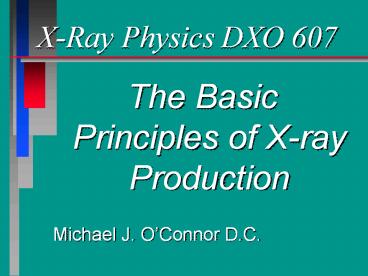XRay PhysicsDXO 607 - PowerPoint PPT Presentation
Title:
XRay PhysicsDXO 607
Description:
Roentgen discovered the ray while experimenting with an induction coil and a ... Roentgen picked up the cardboard and in doing so saw the bones of his hand upon it. ... – PowerPoint PPT presentation
Number of Views:193
Avg rating:3.0/5.0
Title: XRay PhysicsDXO 607
1
X-Ray Physics DXO 607
- The Basic Principles of X-ray Production
Michael J. OConnor D.C.
2
Chapter 1
- Introduction
- To
- X-ray
3
What is a ray?
- A beam of radiant energy which travels as a wave
motion and is measured in terms of energy
wavelength.
4
The Duality of X-ray
- Two types of radiation
- Corpuscular radiation - tiny bits of matter
moving almost as fast as the speed of light. - Wavelength radiation (electromagnetic) - waves of
radiant energy possessing no mass and no weight.
5
The Duality of X-ray
- It was said that x-ray has no mass or weight
however in recent years this concept has been
closely scrutinized questioned. - Example Cathode rays have been shown to have
alpha Beta particles. These particles are of
interest to us as they are the mass particles of
radiation explosions produce radioactive
material.
6
The Duality of X-ray
- A Quanta is a bundle of energy or radiation
- Limiting of electrons in each shell is determined
by 2n2 (n number of the shell) - Example What is the maximum number of electrons
in the third shell? 2(32) 18
7
The Electromagnetic Spectrum
- Electric and Magnetic waves comprise the
electromagnetic spectrum and are arranged
according to their wavelengths. Sixty cycle A.C.
current is the longest, their wave length being
approximately 3000 miles cosmic rays are the
shortest at about one hundred-billionth of an
inch. - X-ray is approximately one billionth of an inch.
8
(No Transcript)
9
What is an X-ray?
- An x-ray or Roentgen ray is a ray that is
characterized by the following physical
properties - Has neither mass or weight -Has No Charge
- Moves in straight lines
- Moves at the speed of light (186,000 mi/sec)
- Is invisible
- Is differentially absorbed by matter
- Affects photographic emulsions
- Produces fluorescence phosphorescence in some
substances - Can ionize gases can damage, kill or stimulate
tissue - Is unaffected by electric or magnetic fields
10
What is an X-ray?
- Milliampere (MA) is responsible for the number
of rays produced. - Kilovolts (kV) is the penetrating power.
- MAS (MA x Sec.) is the product of MA multiplied
by the time of exposure (in seconds)
11
What is an X-ray?
- We can prove the presence of x-ray by
- Their action on photographic emulsion
- Their action on certain crystals causing
fluorescence - Their ionization action on certain gases causing
them to become conductors of electricity - Their action on certain chemical systems causing
them to have a measurable change - Their action on certain substances causing these
substances to change color - Under certain conditions x-ray can be seen
12
The Discovery of X-ray
- X-ray was discovered in 1895 by Wilhelm Conrad
Roentgen while he was the director of the
Physical Institute at the University of Wurzburg,
Bavaria. - Geissler, Crookes and Leonard had prepared the
way by experiments in the preceding 35 years -
most probably producing x-rays many times.
13
The Discovery of X-ray
- Roentgen discovered the ray while experimenting
with an induction coil and a vacuum tube enclosed
in black paper. A sheet of cardboard coated with
barium platinocyanide, a substance known to
fluoresce in the light of such an apparatus,
glowed with all tube light excluded by the black
paper covering.
14
The Discovery of X-ray
- Roentgen picked up the cardboard and in doing so
saw the bones of his hand upon it. He called his
great discovery x-rays - x representing the
unknown. They are often termed Roentgen rays in
honor of their discoverer.

